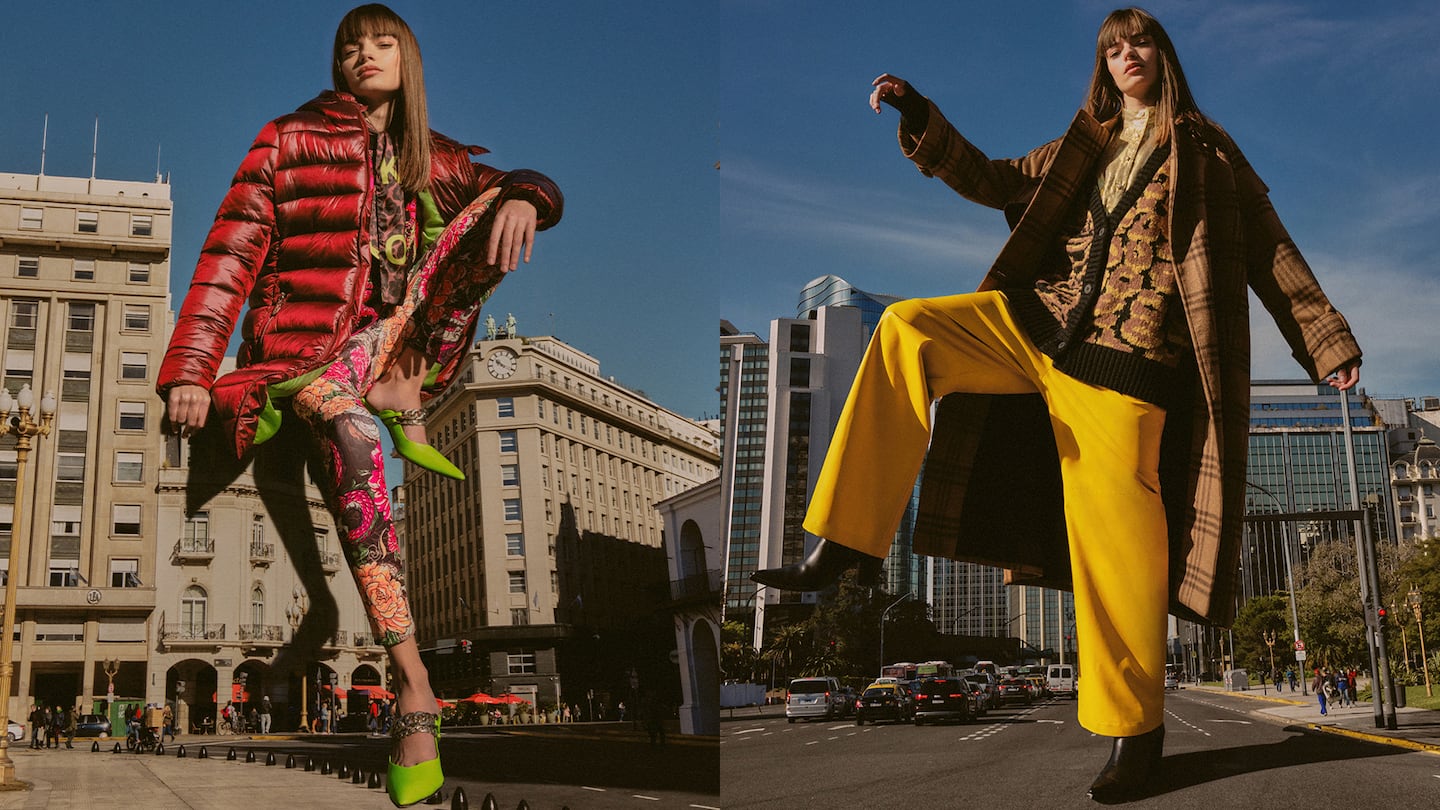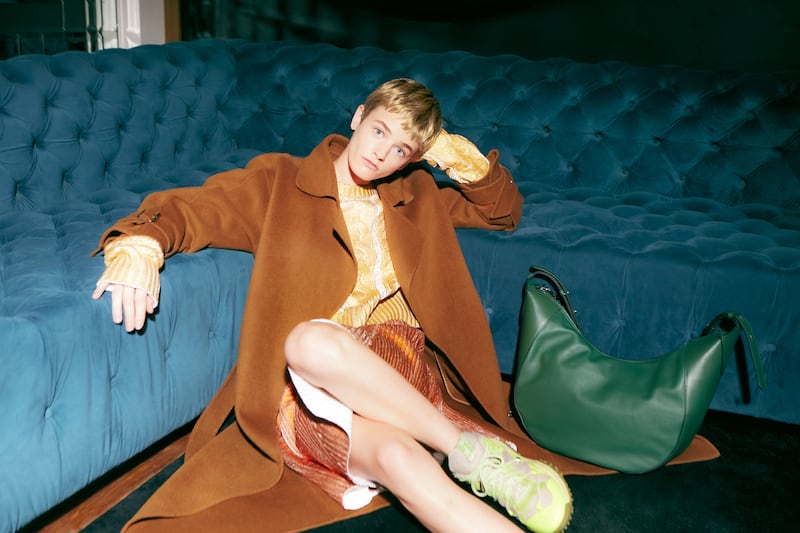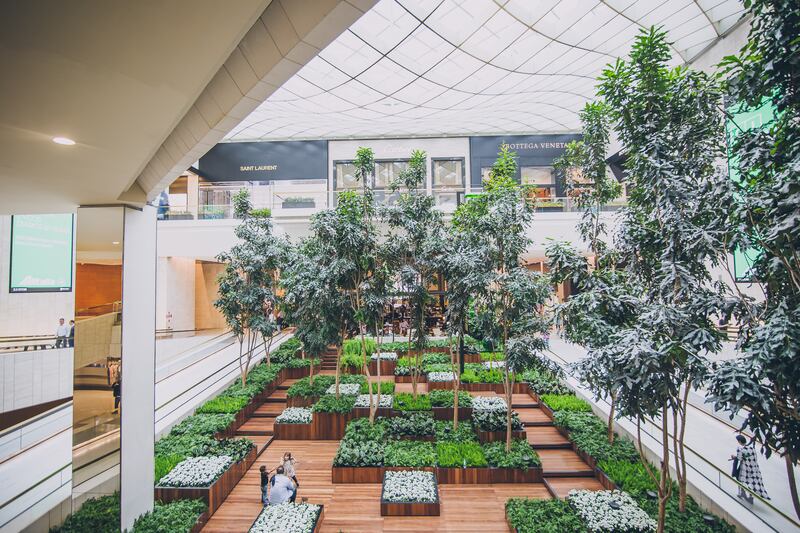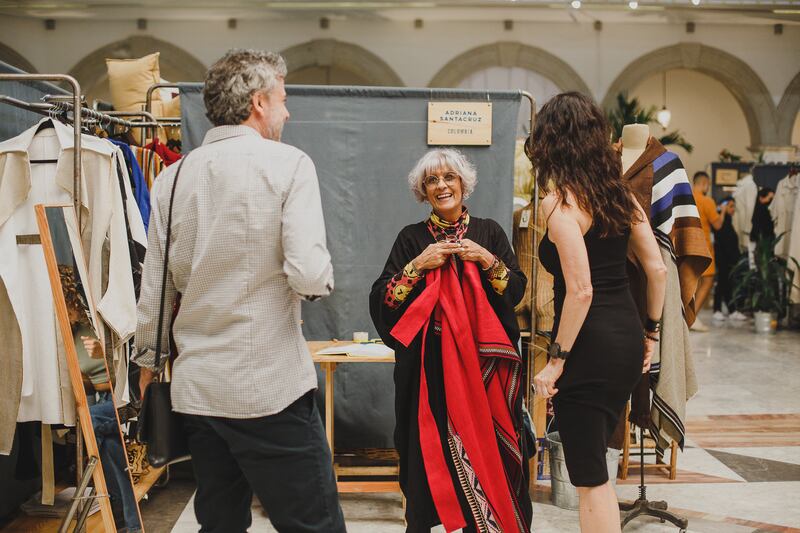
The Business of Fashion
Agenda-setting intelligence, analysis and advice for the global fashion community.

Agenda-setting intelligence, analysis and advice for the global fashion community.

Avellaneda Avenue in Buenos Aires has become a popular destination for those seeking fashion bargains. On a Saturday afternoon, the street bustles with vendors and clothing stores offering dresses that cost less than a burger at a fast-food chain in the Argentine capital.
Many of those looking for discounted clothes are visiting this area for the first time, eager to snap up items for a fifth less than at shops in the more upmarket Santa Fe Avenue district. Lines of up to 100 people form at stalls with people buying trendy imitations, parallel imports, bulk goods and even black-market pieces in an attempt to help them make ends meet. Avellaneda Avenue has become the shopping destination for a middle class in crisis.
“[That area is now like] Argentina’s [answer to] fast fashion; low quality but very cheap,” says Buenos Aires-based strategic research consultant Gaba Najmanovich, who explains that even Zara, one of the few international brands left in the country, has become unaffordable for many due to the dire economic situation in the country.
Over the past five years, Argentina has been subject to some of the highest inflation rates in Latin America due to currency exchange controls and economic instability, with the Covid-19 pandemic only exacerbating the situation. The fashion sector has been hit particularly hard. According to the National Institute of Statistics and Census of Argentina (INDEC), nationwide apparel prices increased by 118 percent in the past year, while headline inflation grew by 83 percent.
ADVERTISEMENT
Yet puzzlingly, the fashion market in Argentina is expected to grow by an ostensibly impressive 8.1 percent from $11.4 billion in 2023 to $12.3 billion in 2024, according to market research provider Euromonitor International. Large Argentine fashion brands like Rapsodia and Kosiuko also appear to be expanding. How can this paradox be explained?
“The forecast for Argentina’s fashion market is expected to be more dynamic than the rest of the region because of a lower baseline,” said Carmen Silva, a consultant for beauty and fashion at the market research firm, adding that hyperinflation, import barriers and a lack of availability of dollars, “explains a lower consumption base by an offer effect rather than demand.”
While the region’s other giants — Mexico and Brazil — have had their share of struggles in recent decades, they have also had periods of growth and relative stability. Argentina’s economy, however, is often described as being in ‘perpetual crisis’, with the International Monetary Fund having provided more than 20 huge financial bailouts including an instalment of $6 billion as recently as December.

The cumulative effect has been soaring poverty rates and a serious decline in living standards for Argentina’s lower- and middle-income consumers. No wonder crowds sometimes exude an air of desperation on Avellaneda Avenue.
However, just a few blocks away in the swanky Palermo neighbourhood, business at one of Argentina’s most prominent fashion labels, Jazmin Chebar, is booming. Affluent consumers and others willing to spend around $120 for a denim skirt flock to the brand’s newest flagship store, complete with a café led by celebrity chef Narda Lepes.
“Despite this hostile economic scenario and inflation, we’re growing; new job posts are being created, and there’s consumption and activity,” says Najmanovich.
While the chasm between the rich and poor is indeed growing, many wealthy Argentines have also seen their fortunes diminish in recent years.
The number of high net-worth individuals (US dollar millionaires) in Argentina nearly halved from around 107,000 in 2016 to 56,000 in 2021, but the group is generally far more insulated from economic shocks than other income groups. By 2026, the number of Argentine millionaires is expected to climb back up to above 90,000, according to last year’s Knight Frank wealth report.
ADVERTISEMENT
In many ways Argentina is an outlier in Latin America, but the polarisation of its fashion market, as seen by extreme luxury on the one hand and the cheapest of value brands on the other, is increasingly apparent across much of the region.
In Brazil, Cristina Betts, who oversees upmarket mall chain Iguatemi reports that the luxury goods market has bounced back there, in part due to so-called “revenge spending” after the economic downturn in 2020, citing a double-digit increase in sales last year compared to 2019.
The chief executive — and her counterparts at competitor malls — saw a repatriation of luxury spending during the pandemic and expressed hopes that the trend will continue if brands’ price harmonisation efforts stay on track.
“You have [more] brands in Brazil at similar price points to Europe and the US now [than before],” and moreover, “brands have realised Brazilians are loyal, frequent consumers,” Betts said.
During the pandemic, Iguatemi opened Balenciaga’s first retail outpost in South America in its Sao Paulo mall where brands like Prada and Burberry also have stores. It expanded its offering on the Iguatemi 365 e-commerce platform to brands like Ermenegildo Zegna.
Recovery of the luxury sector is one thing but whether the fragile recovery of the broader fashion market in the country is sustainable is another matter.
“Retail recovery was strong in 2022, especially if we consider the low comparative base on 2020 and 2021 due to [pandemic-induced disruptions to business],” said Fernando Pimentel, president of the Brazilian Textile and Apparel Industry Association (ABIT).
Government programmes and economic measures helped offset declining retail sales, he adds, but inflation has since diminished consumers’ purchasing power.
ADVERTISEMENT
“Employment has recovered, so there are more people making purchases, but the average income in reais has not improved in two years because of inflation,” said Pimentel.
Economic headwinds help explain why the value of overall apparel and footwear sales in Latin America’s biggest economies, Mexico and Brazil, only reached pre-pandemic 2019 levels in 2022, and why Chile may not recover for a few years yet, according to data from Euromonitor.
But interestingly, thanks to a quicker rebound in some smaller and medium-sized Latin American fashion markets like Colombia, the region as a whole recovered from the pandemic contraction earlier, in 2021.
Mexico and Brazil remain the largest fashion markets in Latin America.
According to Euromonitor, Brazil’s apparel and footwear market is set to grow 1.97 percent from $27.3 billion in 2023 to $27.8 billion in 2024. Mexico’s growth is set to be marginally slower at 1.92 percent from $29.9 billion in 2023 to $30.5 billion.
The broader economic outlook for the region is also mixed, with countries like Colombia, Uruguay, Panama, Ecuador, Bolivia and the Dominican Republic tipped to see higher GDP growth than regional giants Brazil and Mexico both this year and next, and others like Argentina, Haiti and Venezuela still in crisis despite nominal growth. The net effect is that regional economic growth for Latin America and the Caribbean in 2023 is projected by the World Bank to slow to 1.3 percent this year, before increasing to 2.4 percent in 2024.
But there are numerous challenges that put the regional fashion market’s tentative recovery at risk, including inflation and other global economic headwinds, political unrest, rising poverty levels, and long-standing issues with infrastructure.
Still, pockets of growth do present an attractive proposition for fashion players across several cities and demographics. Current levels of spending across the region are nothing to sneeze at either.
The region remains underpenetrated for many global brands that have focussed instead on expanding their footprint across other emerging regions over the last decade. Yet the overall retail value of Latin America’s apparel and footwear market in 2023 stands at $98.9 billion, significantly higher than the $89.2 billion for the Eastern Europe region, and not far off the value of $105.1 billion for the Middle East and North Africa region.
The regional fashion market is on an upward trajectory, forecast to grow 2.7 percent to reach $101.6 billion in 2024, but it will be uneven across geographies and price points.

In Brazil, it is still too early to tell how the return of leftist president Lula da Silva will impact the fashion sector after four years of Jair Bolsonaro’s controversial leadership but some segments of the Brazil market will be more resilient than others. Experts maintain that luxury will continue to be a key growth driver, underpinned by rising levels of wealth.
Knight Frank expects the number of Brazilian millionaires to increase 30 percent between 2021, when they amounted to 324,000 individuals, and 2026.
While some speculate that wealthy Brazilians could resume shopping overseas in great numbers as the post-pandemic recovery continues, José Auriemo Neto, chairman of JHSF Participações, the company behind luxury shopping malls such as Cidade Jardim in São Paulo, doesn’t believe he will lose the domestic custom he gained during the pandemic.
Neto told BoF he hopes to maintain momentum by investing in experiential retail for JHSF tenants and joint venture partners which include Louis Vuitton, Christian Dior, Valentino and Balmain, and strengthening relationships with VIP clients.
But the lower end of the fashion market could be a different story if high levels of inflation drag on. In 2022, Brazil’s overall inflation rate was 9.3 percent while clothing and footwear inflation averaged 16.3 percent.
Brazil and Mexico have both seen an uptick in domestic consumption as their service sectors swung back into business. Still, the tighter lending environment could alter the trend, as central banks have hiked interest rates.
Financial analyst Julian Fernandez says that after Covid-19 restrictions were lifted, consumer spending in Mexico rose due to pent-up demand. “This led to increased revenue and profits for retail companies, such as Walmart and Soriana (a hypermarket that also offers basic clothing items] and department stores like Liverpool, Palacio de Hierro and Sears.”
Like in Brazil, it is the high-end that is in the spotlight. “Luxury is thriving in the Mexico market,” said Karla Martinez, head of content of Vogue Mexico and Vogue Latin America.
Wealth data appears to support her claim. The number of Mexican millionaires increased 2 percent between 2020 and 2021 during the early phase of the pandemic, according to Knight Frank, and the group is forecast to grow 56 percent between 2021, when it swelled to 161,000 individuals, and 2026.
But some luxury players haven’t sufficiently tapped into that growing wealth or didn’t manage to capture sustainable levels of ‘revenge spending’ .
Upmarket department store Saks Fifth Avenue in Mexico closed its last location in Santa Fe, Mexico City, in October 2022 after its Polanco store had already permanently shuttered due to the pandemic. The owner, billionaire Carlos Slim, and his son Grupo Sanborn CEO Patrick Slim Domit, decided not to renew the license, anticipating a more protracted economic downturn. Fierce competition from more established luxury retailers, Palacio de Hierro and Liverpool, probably didn’t help matters.
Recent indicators suggest a short-term downturn in the Mexican mass market. During El Buen Fin, the Mexican equivalent of Black Friday which took place in November, inflation undermined expectations. Sales totalled 134 billion pesos ($7.23 billion), which is 30 percent less than expected by the Confederation of the National Chambers of Commerce (CONCANACO). Moreover, December sales dropped by 16 percent compared to the year before.
“The prevailing assumption was that the trend would persist, but the effects of inflation, surging gasoline prices, disrupted supply chain operations, and the economic fallout from the conflict in Ukraine were not taken into account,” said Alvarez. Now the focus for many mass market consumers has shifted towards fulfilling basic needs.
Once a market that outperformed the region, Chile has been facing significant challenges with a socio-economic crisis that started in 2019, triggered by violent protests in response to inequality, high living costs, low wages and inadequate social services. The government since implemented reforms and constitution changes and a new president, Gabriel Boric, was elected in 2021.
Given this backdrop, it is no surprise that Chile’s apparel and footwear market is a laggard in the region. Still struggling to recover, it isn’t expected to even reach pre-pandemic levels by 2024, Euromonitor forecasts.

Valued at $6.4 billion, this year’s sales in the country is predicted to rise just 0.84 percent to $6.5 next year. High inflation and a recessionary environment continue to dampen the spirits of Chileans, sending sales downhill in the latter half of 2022, with major department stores Ripley and Falabella, and fashion chain Tricot among those affected.
Though not without its own challenges, Colombia appears to be a relative bright spot in the region, with Euromonitor forecasting that its apparel and footwear market will grow 2.9 percent from $7.6 billion to 7.8 billion between this year and next. One growth driver cited by Flavia Santoro, president of ProColombia, the organisation promoting exports and tourism, is the fashion e-commerce sector.
Consumers across many markets in the region are now less hesitant to order online and it’s not just down to higher e-commerce penetration rates ushered in by the pandemic. “Companies like Amazon and Mercado Libre have helped remove the fear of fraud,” said Mexico Fashion Week Director Mike Caro.
Nevertheless, “companies and factories are being cautious with their production and budgeting” in Colombia, said Laura Osorio Damelines, consumer research analyst at Medellin-based Inexmoda. She adds that there is uncertainty due to the new presidency of Gustavo Petro, who took office in August of 2022, and global economic headwinds.
Peru has faced its own set of challenges, including intense political protests and a democratic crisis sparked by years of political turmoil and demands for better living conditions. In December, former president Pedro Castillo was ousted, and vice president, Dina Boluarte, succeeded him following his impeachment after a failed coup attempt.
Despite the crisis, the economy bounced back in 2021 and kept growing last year. The IMF expects it to grow 2.5 percent this year and 3.5 percent next year.
However, ongoing political uncertainty and consumer caution have hit Peru’s apparel and footwear market harder than in many of its neighbours. Euromonitor forecasts that the market will not recover to 2019 pre-pandemic levels even by 2025. In fact, it is the only major market in the region that is expected to contract between this year and next, from $4.4 billion to $4.3 billion.
Across the Latin American region, luxury industry leaders have noted growing interest in local brands and a significant number of consumers allocating a greater share of wallet to them. In Mexico, Vogue’s Martinez points to designer brands placing an emphasis on sustainability like Armando Takeda and Barbara Sánchez-Kane.
Mexico Fashion Week director Mike Caro suggests that it’s not just in the luxury sector that local players are taking incremental market share from international counterparts. “Consumers… [are mixing Mexican products like] Lorena Saravia boots with an H&M tee for example.”
Several of the more established local designer brands found success during the pandemic, noted Regina Barrios, co-founder of Caravana Americana, a Mexican trade show featuring Latin American fashion and homewares. For the 12th edition of the event in February, Barrios welcomed back many international and local buyers who were absent in previous editions looking for niche products for their stores.
“Luxury consumers survive economic downturns and so will designers able to cater to that audience,” Barrios said.
Designers who were once restricted to their domestic market but expand to the wider regional market will be riding a wave of wealth generation. By 2026, Knight Frank forecasts over a million US dollar millionaires across the Latin American region, up 45 percent from 743,000 in 2021.
But with diminishing purchasing power in the mass market, and rising concerns about fashion’s environmental impact, consumers are becoming more interested in circular fashion efforts in the region. Though engagement with companies operating in the resale sector still lags those in other international markets, it does represent an opportunity in larger and more advanced markets.
Used clothing is now a significant source of revenue for several e-commerce platforms in the region. One example is Mexico-based Troquer, which offers second-hand items ranging from Hermès and Dior to Saint Laurent and Valentino. Other popular resale sites in the region include GoTrendier in Colombia, Vopero which sells in Uruguay and Mexico, and Rebloom in Mexico.
In Brazil, established players have used M&A to enter the space. Last year, Iguatemi acquired around 23 percent of Brazil’s largest e-commerce platform for second-hand luxury goods, Etiqueta Negra, for $5.3 million.
Najmanovich says that resale in Argentina is often more about ad-hoc business opportunities in times of crisis. There, resale entrepreneurs use informal social media channels to curate a mix of luxury, high-street fashion, and even their own brands via Instagram. She cites Vestidor Ideal as an example, where “you can find anything from Gucci and Prada, to Bershka and H&M.”
Indeed, even in crisis-prone Argentina, “there is commerce and people are making [fashion] purchases. The issue is how it occurs and where,” she added.
This week’s round-up of global markets fashion business news also features Korean shopping app Ably, Kenya’s second-hand clothing trade and the EU’s bid to curb forced labour in Chinese cotton.
From Viviano Sue to Soshi Otsuki, a new generation of Tokyo-based designers are preparing to make their international breakthrough.
This week’s round-up of global markets fashion business news also features Latin American mall giants, Nigerian craft entrepreneurs and the mixed picture of China’s luxury market.
Resourceful leaders are turning to creative contingency plans in the face of a national energy crisis, crumbling infrastructure, economic stagnation and social unrest.